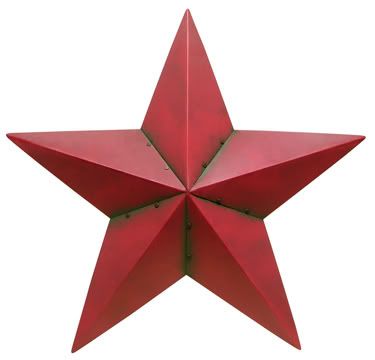

I once heard an occult researcher refer to the Texaco symbol as a pentagram with an altar in front of it. However, could it be a Listian Vehme star rose with an Irminsul in front of it? Guido von List called the common "welcome star" or "barn star"--usually black in color--as an ancient Germanic symbol.... apparently with partly the same basic meaning as the neopagan pentagram. In other words, an ancient European version of the Indo-European or Sumerian pentagram. Actually von List made reference to the Vehme star (also: five-angled star, Truthenfuss, barn star, or welcome star), the Vehme star rose (Pentacle star with outer circle), and the Vehme cross (occultic "exoteric Christian cross" with a hidden "fifth point").
 | |
| "Barn star" (Vehme) of German origin |
An Irminsul is an altar to the Germanic god Irmin... which may have been a representation of Odin, Tyr, or another Germanic god. Some of the meanings were probably lost after Charlemagne had virtually all of them in central Europe destroyed. It sounds like it was an altar to the Germanic god or goddess of choice in the community in which it was constructed. Occasionally, "Irminism" is used as an alternate name for Germanic Neopaganism. Again..... a green Irminsul... in front of a red Vehme star.... surrounded by an outline of the circle of nature. A living green altar to the Germanic gods, within the circle of nature, and amid the literal blood-red (DNA) regeneration of nature and all of it's elements.

 In the red and white Texaco symbol, one can see what appears to be an altar upon a hill or raised platform, and perhaps against the morning or evening sun. If you stare at it, it's as though your subconscious ancestral memory is telling you to ascend the platform. Then compare it to the Irminsul image, also sitting upon a raised platform. Is the Texaco symbol the spirit of Wotan (Irmin) within the five elements (Vehme) of nature (circle)? I had said it in yesterdays posting on a different topic, and I'll say it again... all of you Asutrar, Odinists, Wotanists out there should be all over this. Take the symbol back... "recapture the flag." Reappropriate.
In the red and white Texaco symbol, one can see what appears to be an altar upon a hill or raised platform, and perhaps against the morning or evening sun. If you stare at it, it's as though your subconscious ancestral memory is telling you to ascend the platform. Then compare it to the Irminsul image, also sitting upon a raised platform. Is the Texaco symbol the spirit of Wotan (Irmin) within the five elements (Vehme) of nature (circle)? I had said it in yesterdays posting on a different topic, and I'll say it again... all of you Asutrar, Odinists, Wotanists out there should be all over this. Take the symbol back... "recapture the flag." Reappropriate.Excerpts from EnglishNews.org ("English Asatru News") Irminsul page:
"Irminsul is a pure and ancient Germanic symbol. The name Irminsul is of Old Saxon origin meaning “arising pillar”, or "great pillar that supports”. The concept of Irminsul and its iconic, unique shape is found within the most ancient pure Germanic languages and history, from Sweden to Switzerland..."
"The Irmin component of the name is an Old Saxon adjective that transliterates as “colossal strength” or “Great/strong ”. Irminsul in its literal interpretation potentially refers to the Germanic spiritual concept of spiritual pillars, Irminsuls which are pillars that were used as totems, or statues of worship in the classic shape."
"The name Irmin potentially refers to one of the alternate regional Old Saxon names for Tyr or more realistically with Woden/Wotan/Odin. As the Old Norse attested equivalent of Irmin is Jörmunr which is a name/title ascribed to Woden/Wotan/Odin."
"It should be noted that through Old Norse alone over 220 names of deities have been attributed to different aspects or titles for Odin alone, such as Grim, Hárr, Gondlir and Jörmunr. Factor in all the Old English, Old German and regional variations, the names of Odin must over our entire history have numbered into the thousands."
.


No comments:
Post a Comment